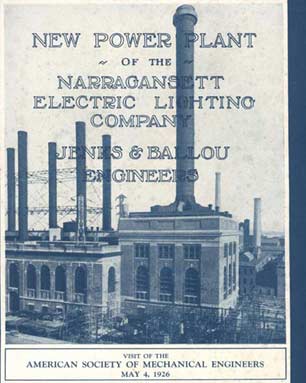A contradiction inherent in any power station is that a privately owned business is responsible for an essential public need – that of the electricity that keeps a modern city functioning. When, for four years between 1998 and 2001, Manchester Street owner USGen failed to pay its bills to Narragansett Electric for energy supplied to the station while it was down for maintenance, Narragansett was unable to follow its usual course of cutting the delinquent customer off – the national company behind USGen supplied many of Narragansett’s regular customers with their electricity. Even now, in February 2009, current owner Dominion Resources is locked in debate with the city of Providence over how much Manchester Street should cost Dominion in taxes. The Manchester Street Generating Station’s status as an operating industrial center complicates the questions of rightful ownership that plague any building navigating the territory between public and private.
But while financial and legal concerns provide concrete examples of the conflicts of ownership present in Manchester Street, the question of psychological ownership of both Manchester Street and South Street is even more intriguing. When two buildings have served a single purpose to a single community for so many years, how does one go about defining their cultural significance and their place in the city’s collective memory?
Both stations have changed ownership multiple times throughout the years, and in 2006 the vacant South Street Station was added to the National Register of Historic Places. With the resulting tax credits in hand, the Heritage Harbor Corporation – to whom the building was donated in 1999 – began planning an extensive transformation of the station. Under the direction of Streuver Bros., Eccles & Rouse, the former power plant will be transformed into a public space called the Dynamo House and will comprise a museum of Rhode Island history, a high-end hotel, a restaurant, and extensive office space. As part of the restoration, Streuver Bros. plans to rebuild six of the nine original smokestacks that once stood on top of South Street Station, returning to it a semblance of its past prominence.

A 1926 Brochure for the South Street Station, courtesy of artinruins.com
But if remembering is the reconstruction of a past unity – as we have discussed in class – then what unity does the cosmetic rebuilding of South Street restore? With the profound change in function that the planned transformation will bring, it is impossible that the station will truly return to what it once was, and even if such a return to a former state were possible, that return would deny the growth and development that Providence has undergone since the dismantling of the station. The renovation seeks to rebuild a memory, but whose? And whose memory does the plan neglect? What history do the city and its the citizens lose when a single commemorative narrative is imposed on a building that has always been a collective possession? My memories of the view across the river include the three stacks of Manchester Street and little else – is that more recent memory deemed invalid in the context of a return to some original history?

Artist's rendering of the Dynamo House, from Streuver Bros., Eccles & Rouse
Back to Hannah Sheldon-Dean's Project: The Manchester Street Generating Station
